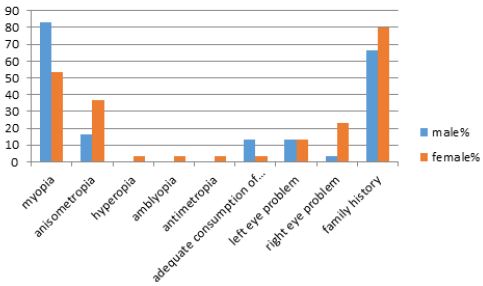Biography
Interests
Ashraful Kabir, M.
Department of Biology, Saidpur Cantonment Public College, Nilphamari, Bangladesh
*Correspondence to: Dr. Ashraful Kabir, M., Department of Biology, Saidpur Cantonment Public College, Nilphamari, Bangladesh.
Copyright © 2019 Dr. Ashraful Kabir, M. This is an open access article distributed under the Creative Commons Attribution License, which permits unrestricted use, distribution, and reproduction in any medium, provided the original work is properly cited.
Abstract
A study was conducted on 60 students (30 male and 30 female) in a Cantonment School of Bangladesh for observing their vision status. Result showed that out of 60 students myopia was the highest in male 83.33% and in female this was 53.33%. Anisometropia was the highest in female 36.67% and in male 16.67%. Hyperopia, amblyopia, and antimetropia were not found in male but in female. Maximum male students were affected vision problems at the age 16 years whereas in female students this was 13 years. Left eye problems were same in both students (13.33%) but right eye problems were higher in female (23.33%) than the male students (3.33%). Female students’ vision problems were related with their family (80%) whereas in male students this was 66.67%. Actually, this was not genetical but it is sure that parents’ unhealthy food habit influenced students’ food habit at all. Close-up prolongs learning (from seat bench to white board, computer, smart phone, book reading etc) were the real causes of vision problems of the students. Myopic male students (83.33%) were showed higher vision problems than the female students because of their continuous use of smart phone.
Introduction
Now-a-days, the vision problems are increasing day by day for the satellite world. Its great use is enhancing
the vision power in Bangladeshi students too. Eye is a vital organ of human body. With both eyes we see everything. Now for the complex and vast education system maximum students of Bangladesh are very busy
for their lesson. They are not habituated to use sunlight in the field. Adequate playgrounds are not available
in most educational institution. Exam after exam they are performing day by day. For communicating with
their parents, friends, relatives, and colleagues they are using smart phone also. In all cases of their activities
the distances are short. They are practiced for using same distances so that their vision is more or less fixed for
seeing any near object. But when they are looking forward feeling blur. Countless use of internet and smart
phone are more vulnerable on their eye related problems. Video game is one of the points in this regard. The
objective of this study is to find out the common vision problems of the students with their remedies.
Students and Questionnaire Method
Questionnaire type information was collected from the students. They were well known about their eye
related problems. They gave all information about their birth also. Collected information were analyzed in
excel program in order to observe the true causes of the vision problems of the students.
Eye Power and Life-Style
Male students were highly vulnerable with their vision problems. Myopia and myopic anisometropia were
the highest for the close-up reading and smart phone using of the students. In addition, food habit of the
students was not good. Mostly they took very few vegetables and fruits but in this work these findings were
not related with such vision problems (Figure 1).

Children who have myopia or hyperopia are more likely to have astigmatism [1]. Family history is a risk factor for some vision disorders such as refractive error as is premature birth [2]. A number of neurodevelopmental disorders (eg. cerebral palsy, down syndrome, autism spectrum disorders, being impairment and speech delay) also are associated with higher rates of vision problems [3]. Children of women who smoked cigarettes during pregnancy have higher rates of strabismus, hyperopia, and astigmatism [1,2,4,5]. National pediatric preventive care guidelines include vision screening by pediatricians yearly at ages 3 through 6 years, and then at regular intervals through late adolescence [6,7]. There is evidence to suggest a genetic influence in the development of refractive errors (in particular myopia) [8,9], it is now generally accepted that environmental factors, such as near work [10,11,12] and outdoor activity [13] also play significant roles. When near work is performed the eyes typically converge and accommodate to maintain clear, single binocular vision of near targets. Potential mechanical pathways are associated with convergence and accommodation which causes asymmetric myopia development [14].
Conclusions
Normally, dark green leafy vegetables are good for eye vision. Give special emphasis for taking adequate
vegetables and fruits. During pregnancy, mother should take more vegetables and fruits for the coming issue.
Close-up continuous reading and smart phone using should be prohibited. Students should take interval
after each ten minutes. They will enjoy in the sun and take part various outdoor activities. Need to practice
for seeing in various distances from the nature. Students should take part eye related yoga with relaxation
process regular for relieving such vision problems.
Bibliography

Hi!
We're here to answer your questions!
Send us a message via Whatsapp, and we'll reply the moment we're available!